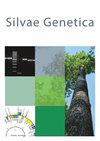Maintaining genetic variation in breeding populations of Radiata pine in New Zealand
IF 1
4区 农林科学
Q3 FORESTRY
引用次数: 0
Abstract
Abstract Advanced generation selection (AS) for the future breeding population (BP), becam a focus of tree breeders‘ thinking in the mid 1970s., particularly with Pinus radiata in New Zealand (NZ). Multitrait selection among families was generally recommended, but this reduced genetic variation in the future breeding population. From Shaw and Hood‘s (1985) stochastic simulation, later confirmed by Rosvall, Lindgren and Mullin‘s (1998) stochastic simulation on Norway spruce, it was realised that selecting within families rather than among families of a new breeding population avoided any reduction of genetic variation in the BP. Heritabilities were low for seedling within-family selection but clonal replication within families should strongly increase heritabilities. Gains from cloned versus seedling populations of equal numbers of plants were also deterministically simulated (Shelbourne et al. 2007), and balanced (within-family) selection gains from the cloned populations were all higher than seedling equivalents at heritabilities of 0.5 and under. The late P.A. Jefferson‘s (2016) Breeding Management Plan (which will be soon superceded) contains a re description of New Zealand (NZ) radiata pine breeding. Selections were made in crosses from the earlier program and OP see and scion material were collected from all 360 selections. OP family tests of selections have been planted at 11 sites in NZ and 7 in New South Wales and Tasmania, and scions of their female parents have all been grafted at an archive. Crosses made in the archive are being cloned and the programme was committed to within-family selection to retain genetic variance for the future closed breeding population. Clonally-replicated testing paired with within-family selection is the solution for balancing long-term gain and diversity in BP and PP.新西兰辐射松育种群体遗传变异的维持
摘要未来育种群体(BP)的进代选择(AS)成为20世纪70年代中期树木育种家们思考的焦点。尤其是新西兰的辐射松(Pinus radiata)。家庭间的多性状选择通常被推荐,但这减少了未来育种群体的遗传变异。从Shaw和Hood(1985)的随机模拟,后来被Rosvall, Lindgren和Mullin(1998)对挪威云杉的随机模拟证实,人们意识到,在一个新的繁殖种群中,在家族内而不是在家族之间进行选择,可以避免BP遗传变异的任何减少。苗期家族内选择的遗传力较低,但家族内克隆复制可显著提高遗传力。从相同数量植物的克隆群体和幼苗群体中获得的收益也进行了确定性模拟(Shelbourne等人,2007),并且在遗传力为0.5及以下的情况下,克隆群体的平衡(家族内)选择收益都高于等效的幼苗群体。已故的P.A. Jefferson的(2016)育种管理计划(即将被取代)包含了新西兰(NZ)辐射松育种的重新描述。从早期项目的杂交中进行选择,并从所有360个选择中收集OP see和接穗材料。在新西兰的11个地点和新南威尔士州和塔斯马尼亚州的7个地点种植了OP家庭选择测试,他们的女性父母的后代都被嫁接到一个档案馆。在档案中制造的杂交品种正在被克隆,该计划致力于在家族内选择,以保留遗传变异,以供未来的封闭繁殖种群使用。克隆复制检测与家族内选择相结合是平衡BP和PP长期增益和多样性的解决方案。
本文章由计算机程序翻译,如有差异,请以英文原文为准。
求助全文
约1分钟内获得全文
求助全文
来源期刊

Silvae Genetica
农林科学-林学
CiteScore
2.20
自引率
10.00%
发文量
10
审稿时长
3 months
期刊介绍:
Silvae Genetica is an international peer reviewed journal with more than 65 year tradition and experience in all fields of theoretical and applied Forest Genetics and Tree breeding. It continues "Zeitschrift für Forstgenetik und Forstpflanzenzüchtung" (Journal of Forest Genetics and Forest Tree Breeding) founded by W. LANGNER in 1951.
 求助内容:
求助内容: 应助结果提醒方式:
应助结果提醒方式:


